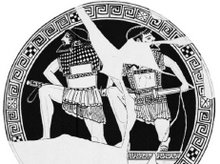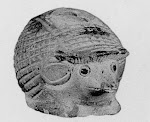Back in 1997 Adrian Goldsworthy wrote a paper (War in History 4:1 1-26) against the literal interpretation of the othismos as a "gigantic pushing match". Before I critique this paper, I want to say that it was very good work. Looking to battlefield universals like morale and understanding the psychology of men in combat was an admirable way of overcoming the fact that much of our evidence, literal and pictorial, can be interpreted in a contradictory manner. In this paper he does not provide new evidence directly against the othismos-as-scrum beyond what was espoused by Cawkwell, Krentz and others. What he does instead is present two quite compelling alternate explanations for why men would fight in deeply massed ranks if not to add their physical weight to the phalanx's pushing power.
For the first explanation he follows Keegan's lead and examines the role of the rear ranks of a deep phalanx in preventing the the front ranks, the only ones fighting in his spear-fencing only scheme, from breaking away from combat. This idea is undoubtedly correct: men in the rear ranks did keep the men before them from running away. This is in part due to their physical presence as a barrier, but perhaps owes more to the psychological boost gained by the knowledge that your compatriots quite literally "have your back."
I won't spend much effort on this argument, because it is quite weak. The author points to 18th century sergeants armed with anachronistic halberds and spontoons as a means of keeping the men of the battle line from fleeing- in armies that most surely did not push. Now, I am Greek and perhaps blinded by hellenophilia, but I have a hard time believing that, if we assume a 2 rank British line, it takes a rear rank depth of 6, 10, 14, or 48 hoplites to do the job of a single man with a Monty Pythonesque pointed-stick. The argument fails on the very universality from which it springs. Why should the Greeks alone require such a specialized formation to deal with a common problem?
His better argument posits that the depth of the hoplite phalanx is based on the need to move large group of men in an orderly fashion. The basic argument is that a group of men of equal size can more more swiftly and in better order in a column than a line. This argument is a red herring though. Sure, a column of 10 files and 50 ranks will move better than a line of 50 files and 10 ranks. What he fails to address is that his scheme does not provide for deployment. Without deploying from column into line, he is facing the enemy with a 10 man front. It is not true that a column of 10 files and 50 ranks move better than a line of 10 files and 8 ranks. Thus we still need to explain the depth of ranks and for this we are back to his morale argument- or othismos as scrum.
A second part of this argument is based on the fact that as formed men charged the ranks thinned out. He quotes Monteuccoli in his description of how men pull apart in the charge such that the actual number of men who reach the enemy at the same time is a fraction of the former front rank. In this argument Goldsworthy is failed by his understanding of crowd movements. He presents a picture of a column of men becoming "scattered" laterally as they advance. This is not what Monteuccoli was describing and in fact is the opposite of what occurs.
As any group of animals, hoplites included, run in a given direction, the faster/braver individuals pull ahead, while the others fall behind. The scatter occurs along the direction of the advance, not a fanning out sideways. Rather than fanning out, the group actually becomes tighter. The reason for this is the same morale effect that the author invokes elsewhere in his article. As the foremost men outpace those behind, the natural tendency is to move closer to the nearest man. This causes the group to narrow as it lengthens. This tendency is common to all herds.
An interesting outgrowth of this is that we would predict that longer charges will actually make for narrower, deeper fronts if the men break ranks. We would expect the original 8 rank phalanx to be deeper and narrower unless the men kept formation through the charge.
As I mentioned much of his other arguments are taken from earlier authors. The notion that a hoplite could not use his weapons and engage in synaspismos is simply a misunderstanding of how such weapons were used and who the targets were. Yes, you cannot stab underhand at the man in front of you, but you can use the spear in your upraised arm quite effectively to stab beyond the man before you and you can use a short chopping or stabbing sword quite effectively. To learn more about my model of Othismos, you'll have to subscribe to Ancient Warfare magazine and get the third issue.
Sunday, August 12, 2007
Subscribe to:
Post Comments (Atom)





2 comments:
What he does instead is present two quite compelling alternate explanations for why men would fight in deeply massed ranks if not to add their physical weight to the phalanx's pushing power.
For the first explanation he follows Keegan's lead and examines the role of the rear ranks of a deep phalanx in preventing the the front ranks, the only ones fighting in his spear-fencing only scheme, from breaking away from combat. This idea is undoubtedly correct: men in the rear ranks did keep the men before them from running away. This is in part due to their physical presence as a barrier, but perhaps owes more to the psychological boost gained by the knowledge that your compatriots quite literally "have your back."
Steve: True, and it explains why the Romans decreased their ranks as they became more professional in the first century AD.
I won't spend much effort on this argument, because it is quite weak. The author points to 18th century sergeants armed with anachronistic halberds and spontoons as a means of keeping the men of the battle line from fleeing- armies most surely did not push.
Steve: No, Paul, you misinterpret that information. First off, I don’t like Goldsworthy, he believes that ancient troops were not that well trained and “maneuvers” were more an accident and less about planning.
The file closer in the two deep and three deep line was really a symbol and not effective. That is because there were not that many of them. Soldiers, especially in the ACW, ran away when they got the chance.
In the ECW the battle /drill manuals had even pikemen at 6 ranks deep a file closer was needed. The manuals still call him by the old Greek name.
His better argument posits that the depth of the hoplite phalanx is based on the need to move large group of men in an orderly fashion. The basic argument is that a group of men of equal size can more more swiftly and in better order in a column than a line. This argument is a red herring though. Sure, a column of 10 files and 50 ranks will move better than a line of 50 files and 10 ranks. What he fails to address is that his scheme does not provide for deployment. Without deploying from column into line, he is facing the enemy with a 10 man front. It is not true that a column of 10 files and 50 ranks move better than a line of 10 men.
Steve: Columns are always easier to move then lines. The barbarians proved that with their use of wedges. Macedonian Ilia and Taxi are columns as well. Deploying a Phalanx from march to a battle line isn’t hard. It’s all about the drill.
An interesting outgrowth of this is that we would predict that longer charges will actually make for narrower, deeper fronts if the men break ranks. We would expect the original 8 rank phalanx to be deeper and narrower unless the men kept formation through the charge.
Steve: This is the precise reason why I believe the Sacred Band of Thebans under Epaminondas was so deep. It allowed them to keep better ranks against the Lakedaemonians so they would strike with some cohesion and disorganize the enemy Phalanx. All my ancient rule systems have the losing phalanx that is pushback from the melee, disorganized and weakened in morale. They usually will lose.
For me, Herodotos gives the reason why Greeks had to be deep besides the morale issue. Read the Greek (Not English) in PW IX.6.9.
"Steve: True, and it explains why the Romans decreased their ranks as they became more professional in the first century AD."
This is probably true for Romans and infantry formations in general, and the morale effect surely explains why Greeks first formed multi-rank formations, but it does not explain the depth of the phalanx. The phalanx actually gets deeper as armies become more professional during and after the Peloponnesean war- from 8 ranks to 12 or 16.
I was being facetious with the comparison to sergeants, though Goldsworthy seems to believe there is commonality. Perhaps a response more tailored to your comment would be why do the ECW pike need 6 and Roman's 8 ranks to do the same function that Greeks used 12, 16, 25, etc.? There is clearly a function beyond simple morale. I would say to lend weight to othismos.
"Steve: This is the precise reason why I believe the Sacred Band of Thebans under Epaminondas was so deep. It allowed them to keep better ranks against the Lakedaemonians so they would strike with some cohesion and disorganize the enemy Phalanx."
Depth doesn't translate to initial cohesion. The number of men that simultaneously make it to the "finish line" after a charge will be similar if the phalanx is a 12 or a 25, and will almost never be more than the number of men in the front rank prior to the charge.
The way to maximize cohesion is to either reduce the distance of the charge to a minimum, lower the speed of the charging men,or both. Of course raising their discipline helps too. This is why Spartans advanced slow and to the tune of flutes to govern the pace.
You are right in that once the men catch up to those who ran ahead, a greater depth will fundamentally place more men on the battle line for othismos. What interests me is that the Greeks may have ended a long charge in greated depth than they started, perhaps deeper in the middle and narrower on the ends or just deeper overall and narrower.
Post a Comment